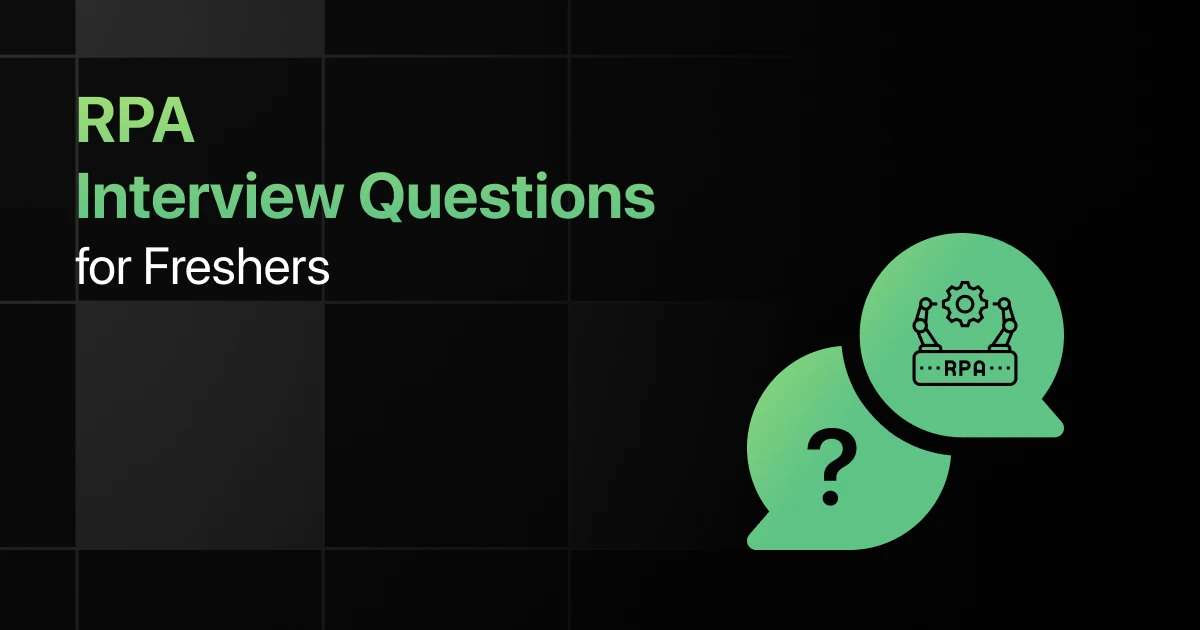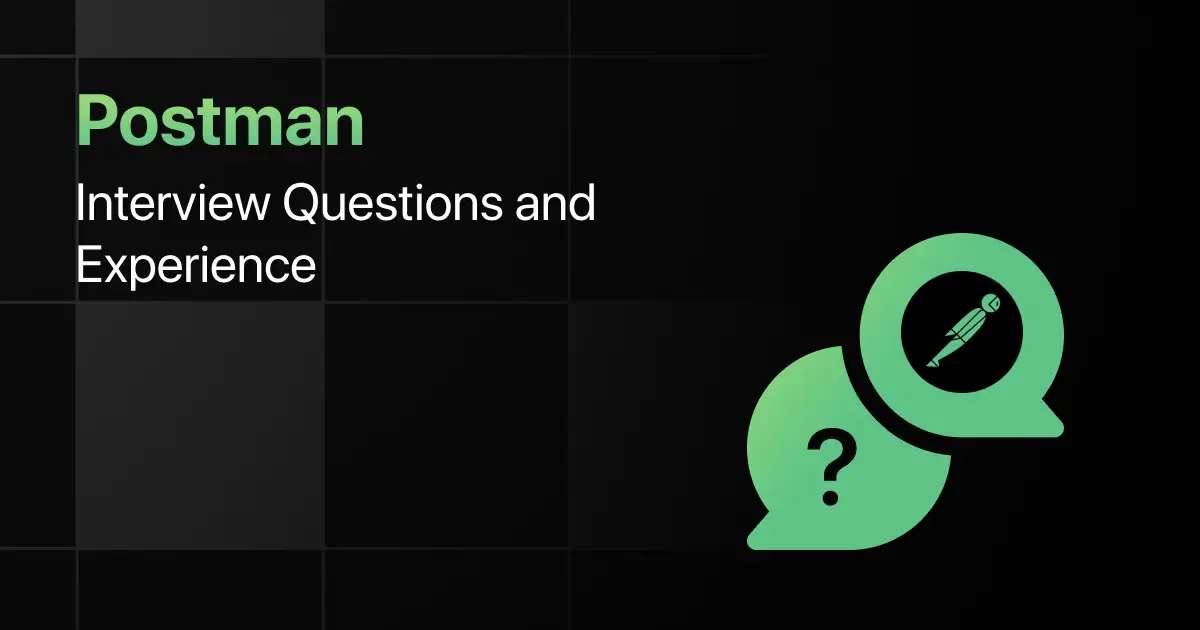Top RPA Interview Questions for Freshers

Are you preparing for your first RPA interview and wondering what questions you might face?
Understanding the key RPA interview questions for freshers can give you more clarity.
With this guide, you’ll be well-prepared to tackle these RPA interview questions and answers for freshers and make a strong impression in your interview.
Practice RPA Interview Questions and Answers
Below are the top 50 RPA interview questions for freshers with answers:
1. What is RPA?
Answer:
RPA refers to the use of software robots to automate repetitive, rule-based tasks without human intervention. It mimics human interactions with digital systems.
2. How does RPA differ from traditional automation?
Answer:
Traditional automation requires coding and integration with systems, whereas RPA mimics user interactions, making it non-intrusive and quicker to implement.
3. What are some common processes suitable for RPA?
Answer:
Processes like data entry, invoice processing, and report generation are repetitive, rule-based tasks well-suited for RPA automation.
4. What is the significance of a ‘bot’ in RPA?
Answer:
A bot is a software application designed to perform repetitive tasks autonomously, reducing manual effort and improving accuracy.
5. How does RPA handle unstructured data?
Answer:
RPA struggles with unstructured data; however, with OCR (Optical Character Recognition) and AI, it can interpret and process unstructured data to some extent.
6. Explain the concept of ‘attended’ vs. ‘unattended’ bots in RPA.
Answer:
Attended bots require user interaction for execution, while unattended bots run autonomously in the background without human involvement.
7. What is the role of ‘selectors’ in RPA?
Answer:
Selectors help RPA bots identify elements within an application’s interface to interact with, ensuring precise control and automation.
8. How does RPA handle exceptions in processes?
Answer:
RPA uses exception handling mechanisms like try-catch blocks to identify and manage errors during automation, preventing process failure.
9. What is the importance of ‘reusability’ in RPA?
Answer:
Reusability in RPA allows you to develop common components, such as workflows or scripts, which can be reused across different automations, enhancing efficiency.
10. Explain the concept of a ‘queue’ in RPA.
Answer:
A queue in RPA is a repository where tasks or items are lined up for a bot to process, enabling parallel processing and load balancing.
11. What are the main phases of an RPA implementation lifecycle?
Answer:
The main phases include planning, development, testing, deployment, and maintenance.
12. How do you ensure RPA scalability in an enterprise?
Answer:
Scalability is achieved by using centralized control, modular workflows, cloud infrastructure, and parallel execution of bots.
13. What is OCR and how does it integrate with RPA?
Answer:
OCR converts scanned images or documents into text, allowing RPA bots to extract data from non-digital formats for further processing.
14. Can RPA work with APIs, and how?
Answer:
Yes, RPA can invoke APIs to access and exchange data between systems, enhancing the scope of automation beyond UI-based tasks.
15. How do you manage the version control of bots?
Answer:
Version control is managed using repositories where different versions of scripts and workflows are stored, allowing rollback or updates as needed.
16. Explain the role of ‘scheduling’ in RPA.
Answer:
Scheduling allows bots to execute tasks at specific times, automating routine tasks without human intervention and optimizing resource usage.
17. What is meant by ‘bot orchestration’ in RPA?
Answer:
Bot orchestration refers to managing and coordinating multiple bots across workflows to ensure optimal execution and load distribution.
18. How does RPA interact with legacy systems?
Answer:
RPA can work with legacy systems through screen scraping or integrating via APIs, making it ideal for systems lacking modern interfaces.
19. How does RPA handle multiple applications in a workflow?
Answer:
RPA can switch between applications and pass data between them, mimicking the actions of a human user.
20. What are the security considerations in RPA?
Answer:
Security in RPA involves data encryption, access controls, audit trails, and ensuring bots have limited and role-based access to systems.
21. Explain how ‘retry mechanisms’ are implemented in RPA.
Answer:
Retry mechanisms are built into workflows to reattempt failed actions, ensuring processes continue even in case of temporary errors.
22. Can RPA handle dynamic web elements, and how?
Answer:
Yes, RPA can handle dynamic web elements by using advanced selectors and custom attribute matching to ensure stable automation.
23. What is the significance of a ‘robotic process designer’ in RPA?
Answer:
A robotic process designer is used to visually design, test, and deploy automation workflows, making the development process user-friendly.
24. How does RPA help in compliance-related processes?
Answer:
RPA ensures consistent execution of tasks, maintains logs, and provides audit trails, making compliance-related processes more reliable and transparent.
25. What is the difference between synchronous and asynchronous bots?
Answer:
Synchronous bots complete one task at a time, while asynchronous bots can handle multiple tasks simultaneously or independently.
26. How do you perform load balancing in RPA?
Answer:
Load balancing distributes tasks across multiple bots or servers to prevent overload and optimize resource utilization.
27. What is meant by ‘citizen developers’ in RPA?
Answer:
Citizen developers are non-technical business users who can build basic automations using low-code RPA tools, expanding automation capabilities across an organization.
28. What is process mining and how does it relate to RPA?
Answer:
Process mining analyzes business processes through event logs, identifying automation opportunities and optimizing existing workflows.
29. How does RPA handle data validation?
Answer:
RPA uses predefined rules or logic to validate data during automation, ensuring the accuracy and consistency of inputs and outputs.
30. What are the benefits of using AI in RPA?
Answer:
AI enhances RPA by enabling bots to handle unstructured data, make decisions, and improve automation of complex, non-rule-based tasks.
31. How do you debug RPA workflows?
Answer:
Debugging involves using logs, breakpoints, and step-by-step execution to identify and fix errors in workflows.
32. How does RPA handle file manipulation?
Answer:
RPA can automate file manipulation tasks like reading, writing, and moving files using built-in file handling functions.
33. Explain the role of ‘workflows’ in RPA.
Answer:
Workflows define the sequence of tasks or actions a bot will execute, guiding it through the automation of a process step by step.
34. What is ‘process orchestration’ in RPA?
Answer:
Process orchestration involves coordinating multiple bots or workflows to complete a larger, end-to-end business process efficiently.
35. What is the role of ‘error handling’ in RPA?
Answer:
Error handling mechanisms ensure that when an unexpected event occurs, the bot manages it gracefully, either retrying or logging the issue for further action.
36. How does RPA manage credentials securely?
Answer:
RPA uses credential vaults to securely store and manage access to sensitive information like usernames and passwords.
37. What is the importance of logging in RPA?
Answer:
Logging tracks the execution of bot activities, providing insights into performance, errors, and exceptions for audit and troubleshooting purposes.
38. How do RPA bots interact with databases?
Answer:
RPA bots can connect to databases via SQL queries or connectors to read, write, and manipulate data during automation processes.
39. Can RPA handle multiple languages in global processes?
Answer:
Yes, RPA can handle processes in multiple languages by using language-specific scripts or leveraging AI for translation and interpretation.
40. What is the impact of RPA on business process re-engineering?
Answer:
RPA complements business process re-engineering by automating tasks and enabling quicker process optimization with minimal system changes.
41. How does RPA ensure data integrity?
Answer:
RPA ensures data integrity by following consistent rules, performing validations, and logging every transaction for traceability.
42. What are the challenges in scaling RPA in an organization?
Answer:
Challenges include managing bot maintenance, ensuring process standardization, integrating across systems, and scaling infrastructure.
43. What is a ‘center of excellence’ (CoE) in RPA?
Answer:
A CoE in RPA is a centralized team responsible for governance, best practices, and ensuring effective use of RPA throughout the organization.
44. How does RPA ensure business continuity?
Answer:
RPA ensures business continuity by automating critical processes, reducing dependency on manual interventions, and minimizing errors.
45. How do you handle structured vs. unstructured data in RPA?
Answer:
RPA handles structured data directly, while unstructured data requires tools like OCR and AI to process and extract meaningful information.
46. What are the factors to consider when choosing an RPA process?
Answer:
Key factors include process volume, repetition, complexity, and the potential for rules-based decision-making.
47. How does RPA improve employee productivity?
Answer:
By automating repetitive tasks, RPA allows employees to focus on higher-value activities, increasing their productivity and job satisfaction.
48. What is the importance of continuous improvement in RPA?
Answer:
Continuous improvement in RPA involves regularly refining bots and processes to enhance efficiency, reduce errors, and adapt to changing needs.
49. How does RPA help in decision-making processes?
Answer:
RPA can automate rule-based decisions and, when integrated with AI, can support more complex decision-making by analyzing data.
50. What are the limitations of RPA?
Answer:
RPA is limited to rule-based processes and struggles with cognitive tasks or complex decision-making without AI integration.
Final Words
Getting ready for an interview can feel overwhelming, but going through these RPA fresher interview questions can help you feel more confident.
With the right preparation, you’ll ace your RPA interview but don’t forget to practice RPA tool basics, bot creation, and automation workflow-related interview questions too.
Explore More RPA Resources
Explore More Interview Questions
- Python
- Java
- SQL
- React
- JavaScript
- C Programming
- HTML
- CSS
- Angular
- C++
- Spring Boot
- Node JS
- Excel
- C#
- DBMS
- PHP
- Linux
- Operating System
- MySQL
- Spring
- Flutter
- MongoDB
- Django
- React Native
- jQuery
- Bootstrap
- Embedded C
- DSA
- R Programming
- Hadoop
- .NET
- Power BI
- ASP.NET
- ASP.NET MVC
- Android
- Tableau
- MVC
- WordPress
- TypeScript
- Spark
- Kotlin
- Swift
- Golang
- Shell Scripting
- iOS
- Spring MVC
- Next JS
- AWS
- Kubernetes
- Docker
- Cyber Security
- Azure
- Terraform
- Vue JS
- UiPath
- Scala
- Flask
FAQs
The most common RPA interview questions include automation tools like UiPath or Blue Prism, workflow creation, and bot management.
Freshers should focus on RPA topics like process automation, bot development, exception handling, and understanding RPA tools.
Freshers should prepare by building simple automation workflows, learning RPA tools, and understanding basic programming concepts relevant to RPA.
Freshers can solve RPA coding questions by breaking down processes into smaller tasks, automating step by step, and ensuring proper exception handling.
Yes, freshers should prepare for advanced RPA topics like integrating RPA with AI, using cognitive automation, and process optimization techniques.
Related Posts


Paytm Interview Questions and Experience
Preparing for a Paytm interview requires a clear understanding of the company’s hiring process, the type of questions asked, and …
Warning: Undefined variable $post_id in /var/www/wordpress/wp-content/themes/placementpreparation/template-parts/popup-zenlite.php on line 1050







